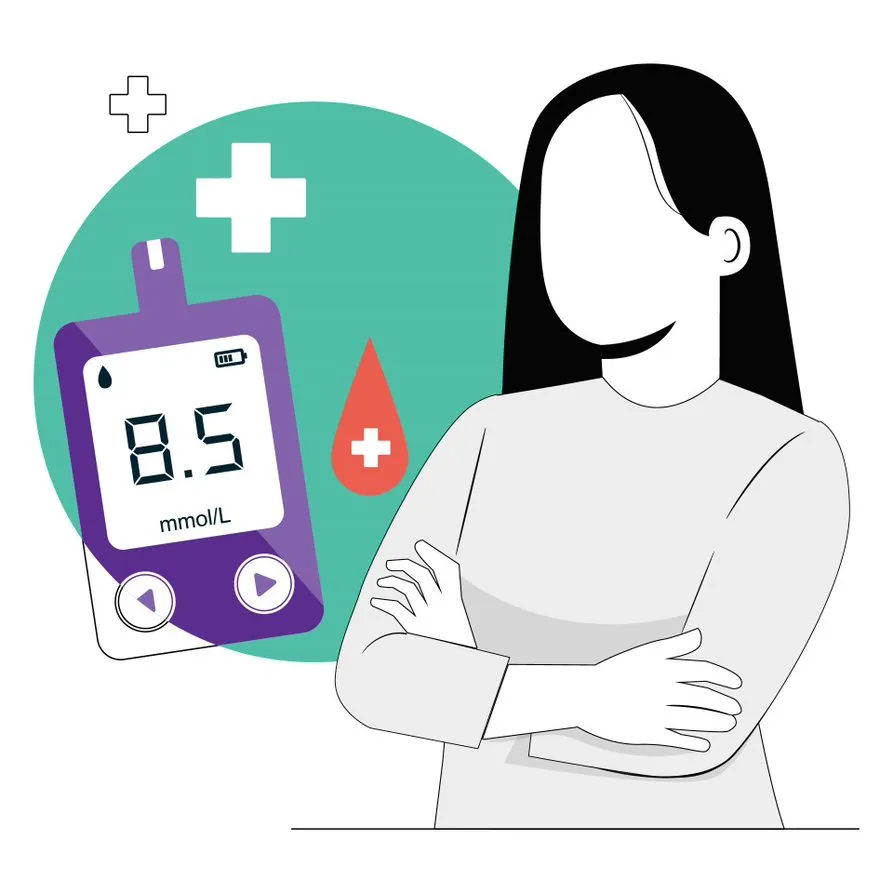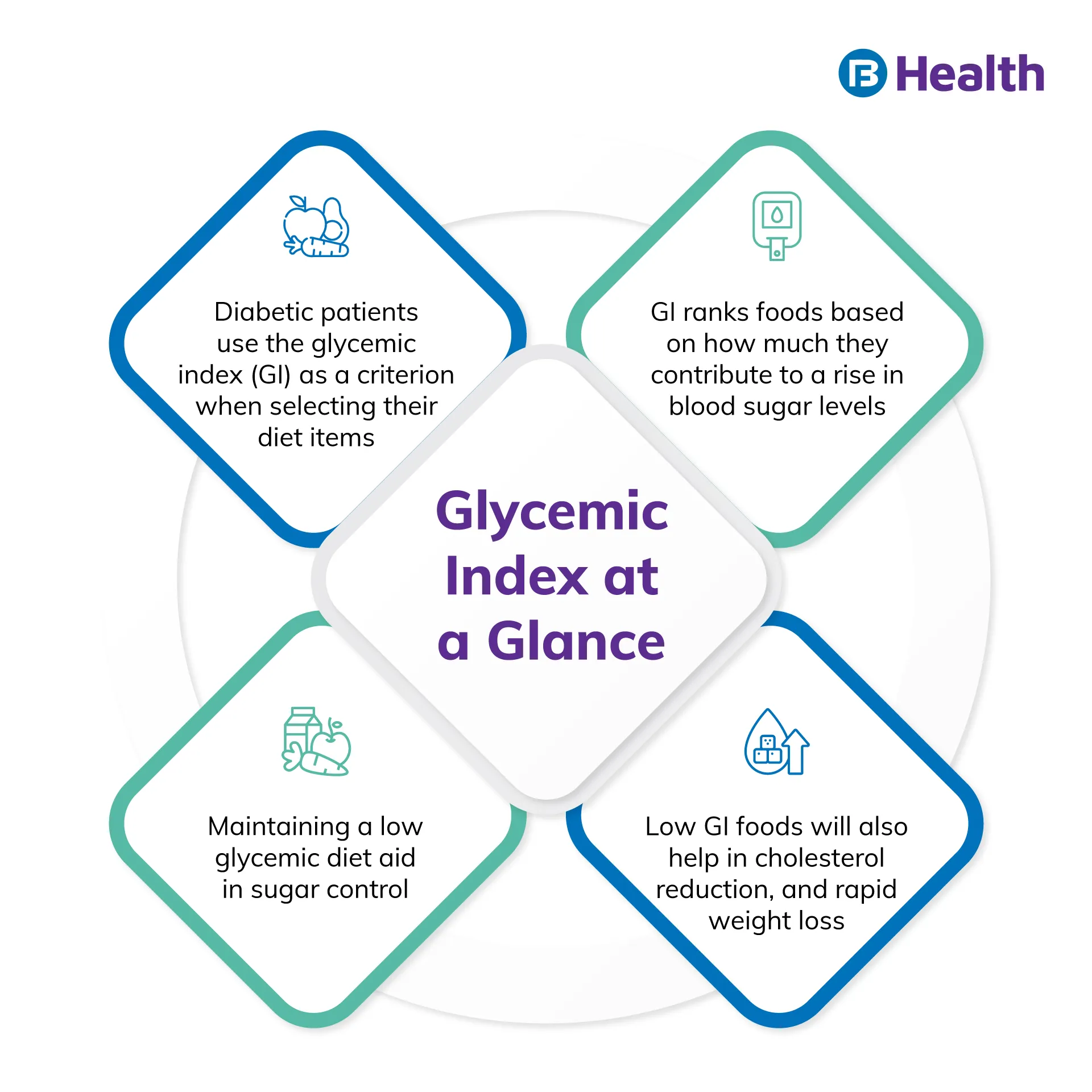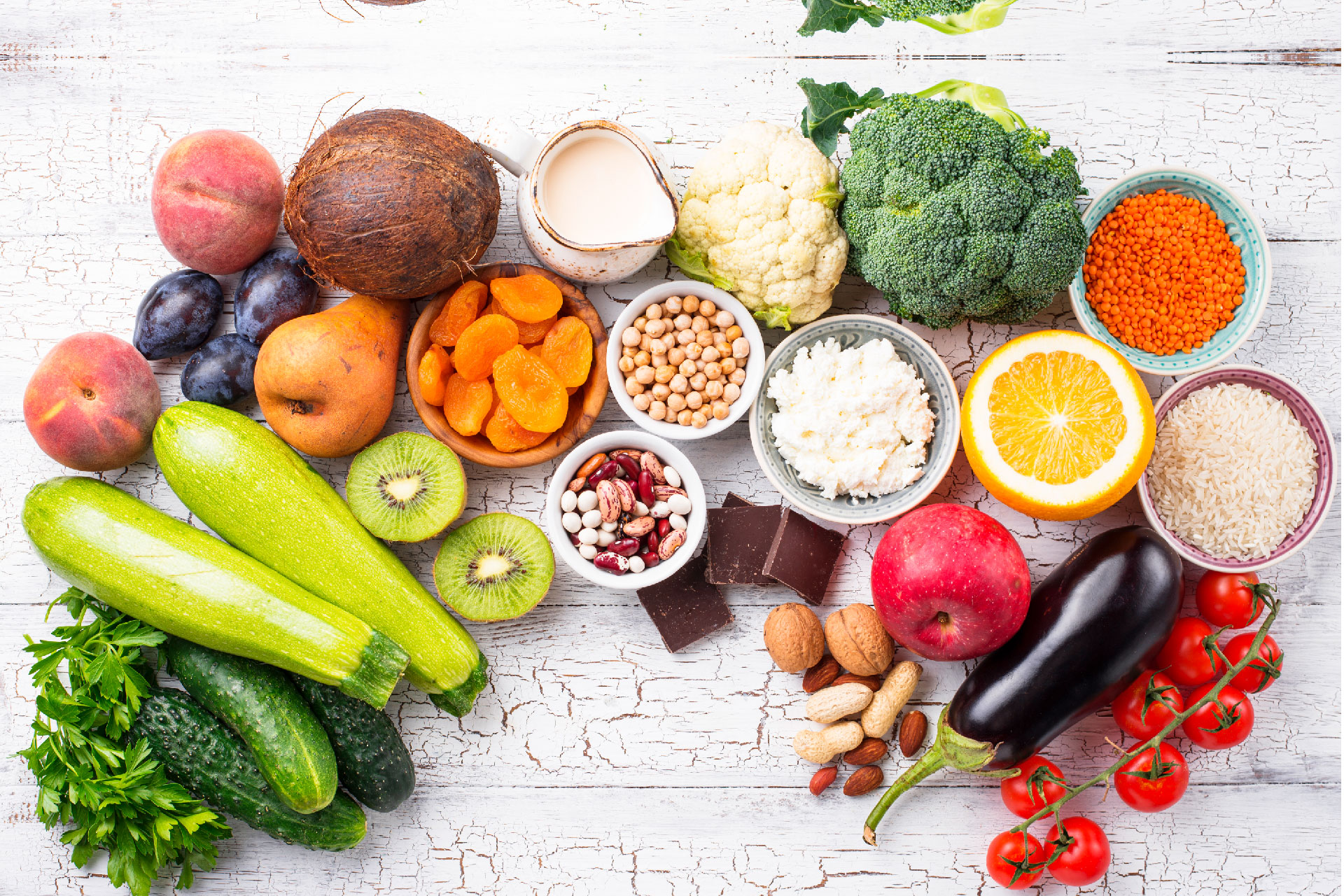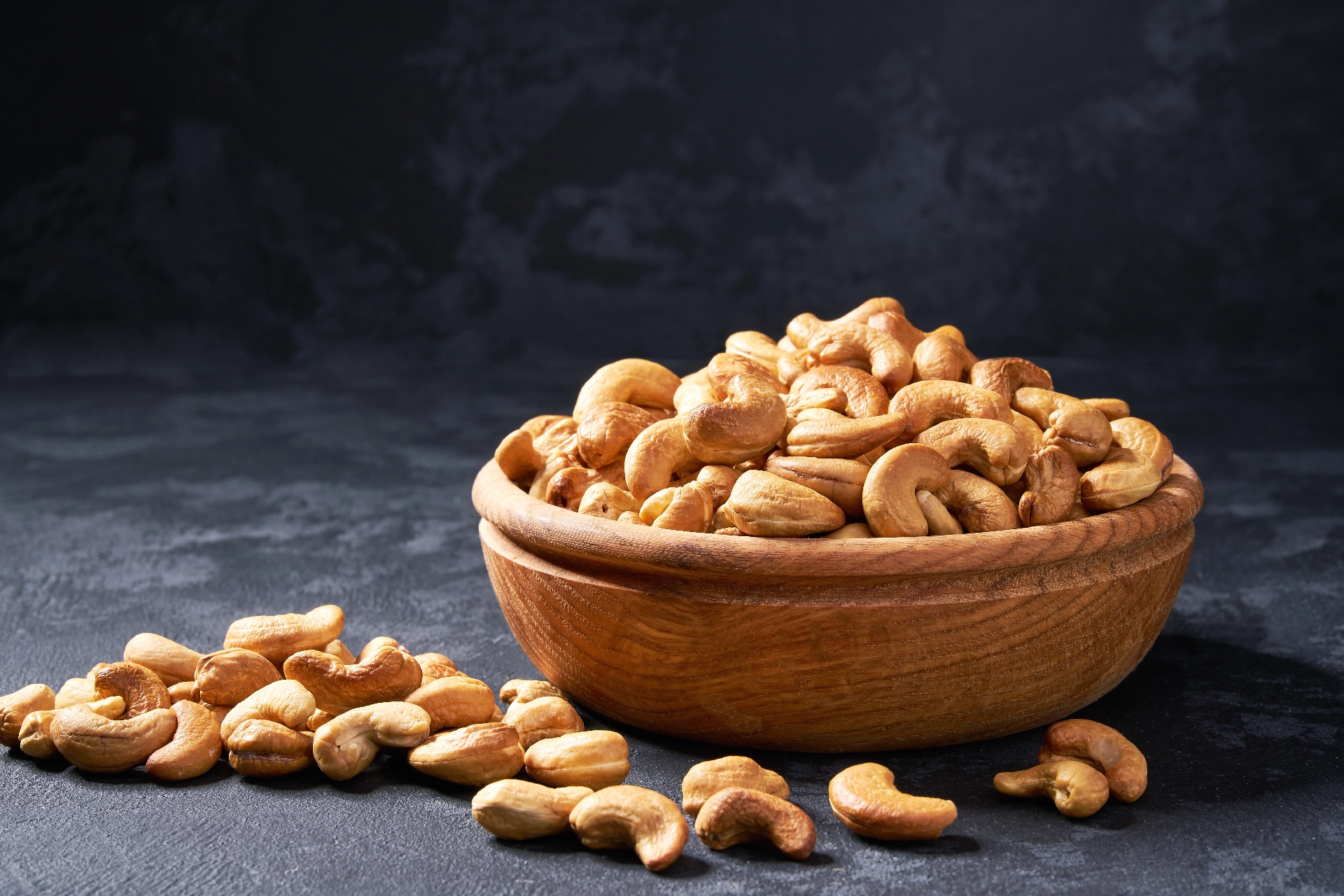General Physician | 7 min read
Glycemic Index: Benefits, Ways to Use it and Formula
Medically reviewed by
Table of Content
Synopsis
Maintaining a healthy lifestyle concerns essential considerations, including how much time you devote to physical activity, how much sleep you get each night, and how much stress you allow yourself to endure. In addition, if you have diabetes or another chronic condition, talking to your general physician about how to use the glycemic index chart in your daily life is a must.
Key Takeaways
- A food's potential impact on blood sugar levels is quantified using a scale called the glycemic index (GI)
- The glycemic index of a food can be affected by its nutrient content, ripeness, cooking method, and degree of processing
- Low glycemic foods have the potential to improve your health in several ways
Some foods cause a sharp increase in blood sugar. This is because quickly digested carbs, like those found in vegetables and whole grains, take longer to convert into glucose, the sugar your body uses for energy, and thus are preferable. However, even with insulin and other diabetes medications, maintaining a healthy blood sugar level will be challenging if you consume a diet high in simple carbohydrates. To distinguish the slow-acting "good carbs" from the fast-acting "bad carbs," the glycemic index was developed. Using it, you can fine-tune your carb counting and help maintain more consistent blood sugar levels.
What Is the Glycemic Index?
The Glycemic Index (GI) ranks carbohydrate-containing foods by how quickly their consumption raises blood sugar levels. Foods that don't cause significant increases in blood sugar (glucose) help maintain stable glucose levels, especially for those with type 2 diabetes.
Keeping your blood sugar steady is easier to achieve when you have a firm grasp on the glycemic index of the carbohydrates you consume.
Additional read: High Fiber Foods for DiabeticsLower numbers indicate less of an effect on blood sugar levels.
- 55 or less = Low (good)
- 56- 69 = Medium
- 70 or higher = High (bad)
Find the glycemic index food chart. Likewise, check out the lists of typical foods and their glycemic indexes online.

How Is the Glycemic Index Derived?
A stringent testing procedure determines index values. First, each participant consumes 50 grams of the same digestible carbohydrate (the test food), and two hours later, their blood glucose levels are measured and graphed, and the area under the curve (AUC) is calculated.
On another occasion, the same 10 participants had their glucose response AUC measured 2 hours after eating 50 grams of pure glucose (the reference food).
Each person's glucose AUC is measured and then divided by their reference food's AUC to determine the test food's GI value. Finally, all ten values are averaged together to determine the final GI score.
| High GI Food | Low GI Food |
| Rice | Oats |
| French Fries | Sweet Potato Fries |
| Cheerios | Apples, Raspberries, Strawberries |
Calculating the Glycemic Index
Researching how 50 grams of carbohydrate-containing food affects blood sugar levels allows scientists to assign a GI value to the food (not including fiber). Subjects' blood sugar is measured two hours after eating, and they are asked to abstain from eating beforehand to eliminate any confounding variables.
A glycemic index of 55 or less is deemed low [1]. Scientists measure the effect of the food on blood sugar and give it a GI score between 0 and 100. According to the GI scale, 100 represents pure glucose, the reference standard. The following is the grading scheme recommended by Harvard Medical School:
- Foods like apples, green beans, oat bran, and non-starchy vegetables are good examples.
- The GI range of 56 to 69 is regarded as moderate. Some foods in this category include green peas, yam, couscous, macaroni, and cheese.
- GI values of 70 and up indicate high-risk foods. Some cold cereals, watermelon, potatoes, the vast majority of bread, and sweets fall into this category.
- While the existing glycemic index lists are pretty comprehensive, they are far from complete. However, you can still use the ratings to predict how other foods in the same category fare.

Difference Between Glycemic Index and Glycemic Load
Some people are skeptical of the GI because it does not account for the quantity eaten or the presence or absence of other nutrients like protein, fat, vitamins, minerals, and antioxidants. However, if you base your diet on the GI, you'll miss out on a lot of other information that can help you determine the actual health value of a food.
The Glycemic Load (GL) index was developed to address the quantity problem by considering the total amount of food consumed. Therefore, the quality and quantity of carbohydrates are considered when calculating glycemic load.
Multiplying the GI by the total amount of carbohydrates (in grams) and dividing by 100 yields the glycemic load. An apple, for instance, has a GI of 40 and 15 grams of carbohydrates [2]. This means an apple has a glycemic load of 6, or (40 + 15)/100.
Benefits of Referring to the Glycemic Index
Understanding GI can help you determine which foods are best for glucose management because carbohydrates are what cause a rise in blood sugar.
Some advantages of using the GI list to guide meal preparation include:
- The method encourages moderation in carbohydrate consumption rather than a complete or extreme cutback
- Whole grains, fruits, veggies, and legumes tend to fall on the lower end of the GI spectrum, while processed foods tend to fall on the higher end of the GI spectrum.
- Following a GI-based diet may allow you to reduce your reliance on conventional vegetarian diet methods like calorie counting and portion control, though this will depend on your individual needs and goals.
- It may be more sustainable in the long run to be more mindful of your carb choices rather than limit them severely.
Drawbacks of Using the Glycemic Index
- As food GI can vary with several factors, it is not always a reliable indicator of food quality
- The rise in blood sugar that follows a meal can be affected by its composition.
- The effect on blood sugar after eating an apple may vary depending on whether you eat it alone or with peanut butter.
- Increased blood sugar levels are mitigated by the fact that protein and fat slow the digestion of carbohydrates.
However, this does bring up an important point: the glycemic index is still nothing more than a set of numbers. Moreover, every person's genetic makeup and blood sugar level are different, so it's impossible to generalize how a particular food will affect them.
Assessing the Effects of a Food in Terms of GI Index
According to the American Diabetes Association, the two most essential factors in determining the post-meal rise in blood sugar are the number of carbohydrates consumed (in grams) and the amount of readily available insulin.
Checking blood sugar levels two hours after a meal is the most accurate way to gauge the impact of what you eat on your body. Two hours after the start of a meal, a blood sugar result of less than 180mg/dL is ideal for most people. Discuss your blood sugar goals with your doctor if you're unsure.
Guidelines for Including GI and GL in Your Diet and Everyday Life
Start by taking stock of what you eat regularly. Learn more about the glycemic impact of oatmeal by looking it up in a glycemic index list or database if it is a regular part of your diet. Eat foods on the lower end of the glycemic index to maintain a healthy blood sugar level.
Combining high-GI foods with protein, healthy fats, and fiber is recommended. For example, mix mashed potatoes (GI 83) with boiled carrots (GI 39) and roasted turkey (GI 83). With this method, your body will have more time to break down the carbohydrates. In addition, you can easily replace high-GI foods with low-GI alternatives.
To sum up, a person's glycemic index score can be used to guide them toward more nutritious food choices. The benefits of a low GI diet serve as the best home remedies for diabetes and patients who are overweight or are at risk of cardiovascular disease, but everyone also feels them.
Avoiding all high glycemic foods is unnecessary when following a low GI diet. Instead, it's more important to maintain stability over time, mainly eating low-GI, high-fiber foods. Incorporating many different low GI food options into your diet can be challenging. Still, with the help of online doctor consultation or dietitian, you can create a healthy and delicious diet.
References
- https://www.betterhealth.vic.gov.au/health/healthyliving/carbohydrates-and-the-glycaemic-index#:~:text=low%20GI%20(less%20than%2055,bread%20and%20short%2Dgrain%20rice.
- https://www.betterhealth.vic.gov.au/health/healthyliving/carbohydrates-and-the-glycaemic-index
Disclaimer
Please note that this article is solely meant for informational purposes and Bajaj Finserv Health Limited (“BFHL”) does not shoulder any responsibility of the views/advice/information expressed/given by the writer/reviewer/originator. This article should not be considered as a substitute for any medical advice, diagnosis or treatment. Always consult with your trusted physician/qualified healthcare professional to evaluate your medical condition. The above article has been reviewed by a qualified doctor and BFHL is not responsible for any damages for any information or services provided by any third party.



